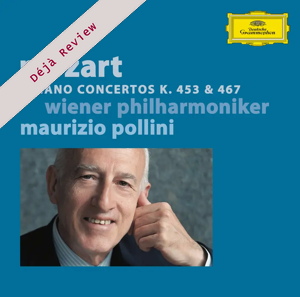
Déjà Review: this review was first published in January 2007 and the recording is still available.
Wolfgang Amadeus Mozart (1756-1791)
Piano Concerto No. 17 in G, K453 (1784)
Piano Concerto No. 21 in C, K467 (1785)
Vienna Philharmonic Orchestra/Maurizio Pollini (piano)
rec. live, May 2005, Grosser Saal, Musikverein, Vienna
Deutsche Grammophon 477 5795 [57]
A wonderful disc in many ways. Pollini has never taken off as a conductor, but he did record a Rossini opera (La donna del lago) and he has previously directed orchestras in concertos. I heard him as long ago as 1982 with the ECO in Manchester’s Free Trade Hall in Nos. 14 and 17; then again a few years later at the Queen Elizabeth directing No. 21 – the orchestra escapes me.
This is his first Mozart concerto recording minus the intermediary of a separate conductor. As such it opens a new chapter in Pollini’s recorded legacy. The ‘live’ element brings an added edge to the concertos along with the occasional characteristic Pollini singalong or gruntalong!
Pollini played No. 17 in the above-mentioned Manchester concert; the first time I encountered great pianism. His Vienna reading is perhaps a little less spontaneous, yet it contains myriad details culled from a lifetime’s experience. Similarly, the VPO – perhaps as a result of his conducting – seem a little lacklustre. Amazingly it is easy to forget the greatness of the orchestra and instead concentrate on Pollini’s contribution. Yet Pollini’s playing is consistently insightful, clear and always supremely intelligent.
For the G major, he plays Mozart’s own cadenzas, always with conviction. The slow movement is a dream – here, more than in the first movement, one feels soloist and orchestra are working as one. Interestingly, in an online interview (nla), Pollini refers to Mozart’s cantabile; in his Mozart Year recordings, Martino Tirimo also refers to the vocal – specifically the operatic – nature of Mozart’s piano writing. It is in the slow movement that this concept is most evident. The finale continues the good work. Pollini’s left-hand dexterity is a marvel and here his direction of the orchestra is surer. The structure of the movement is as clear as Pollini’s articulation, the coda appearing as the perfect way to close, bustling with Figaro-like energy.
The concerto K467 is arguably the most popular of the cycle. Maybe that is why Pollini intriguingly used cadenzas by his contemporary, Salvatore Sciarrino, to add a new dimension? A daring and provocative move, it adds a further layer of interest to the experience.
The first movement balances the tense opening with moments of tender relaxation. At times it almost seems as if Pollini is loving the music as he plays – a very uncharacteristic trait, one might argue. Sciarrino’s cadenza is exploratory – more so than most – but remains within its Mozartian remit. The famous Andante features string lines spun of the finest silk and speaks of truly Mozartian repose. True, there is angst in the sforzandi around the 4:40 mark, but this seems to highlight the prevailing calm. The finale begins in the spirit of opera buffa before a short extempore from Pollini. Energy abounds here, with Pollini eschewing any temptation to needlessly indulge in rubato. The cadenza is a veritable explosion, and so acts as a logical extension of Mozart’s inexhaustible energy. This is tremendous, life-affirming Mozart playing, marking Pollini’s welcome return to this territory.
Colin Clarke
Buying this recording via a link below generates revenue for MWI, which helps the site remain free.



















